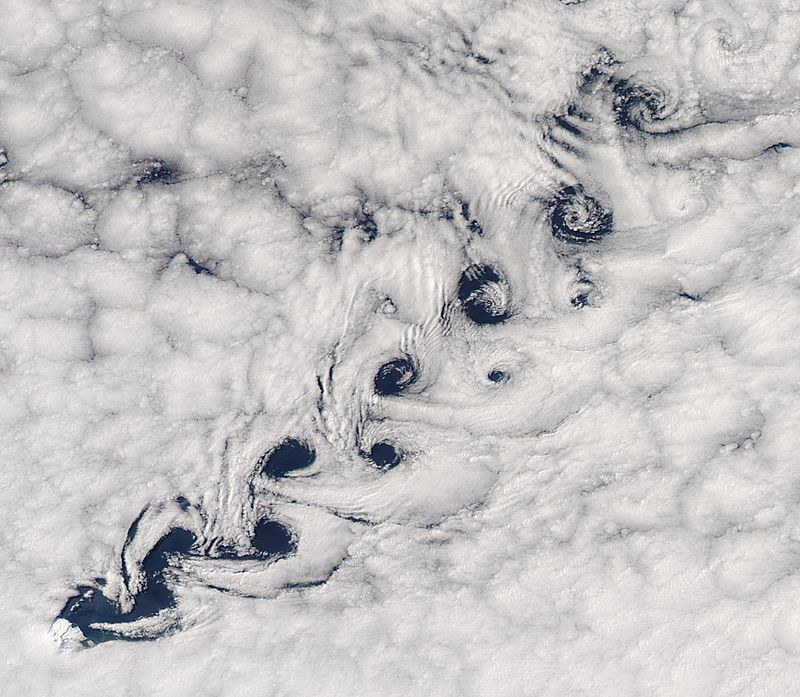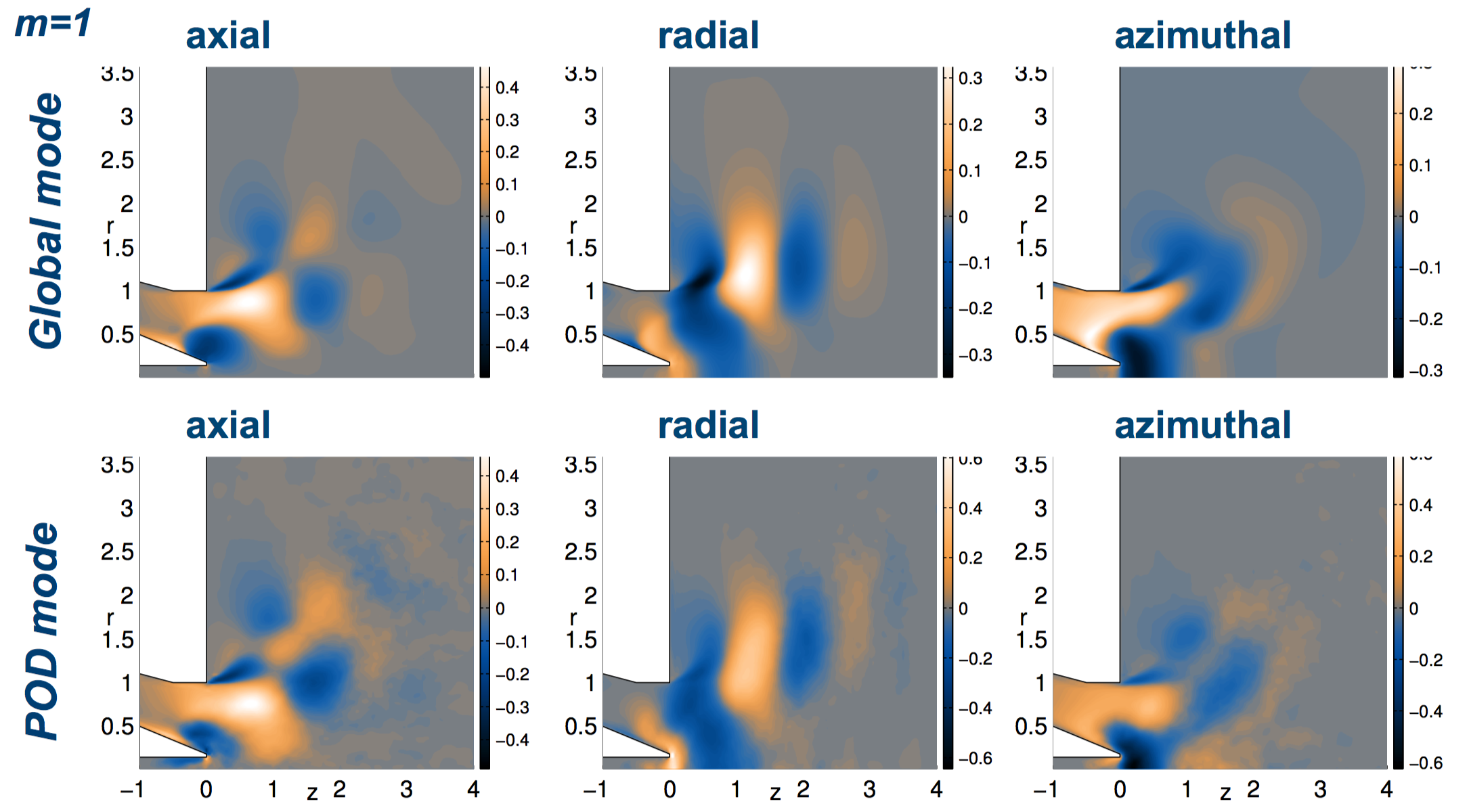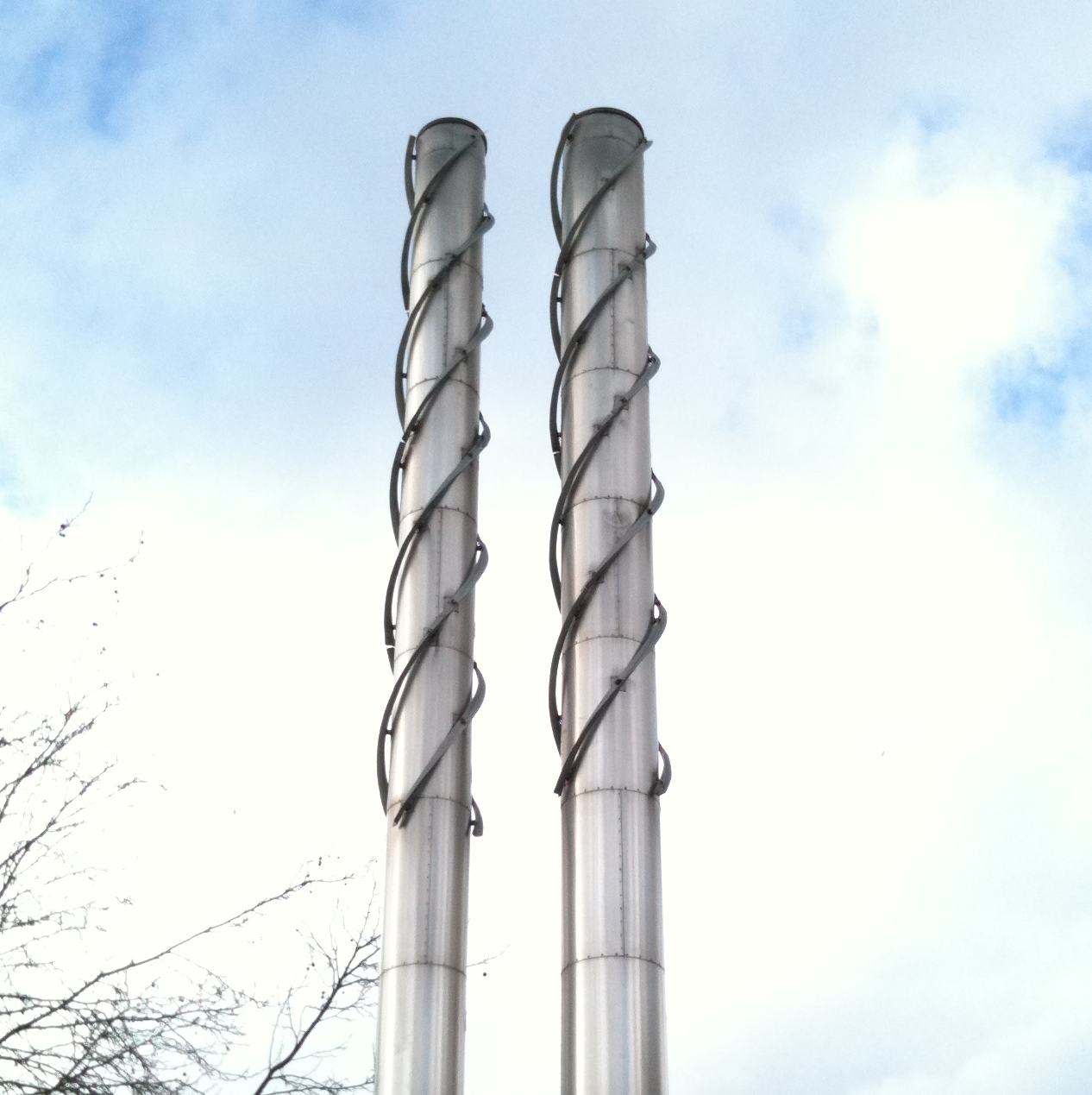
There is a standard procedure for performing a stability analysis on a flow. (i) Choose the governing equations and boundary conditions (e.g. the Navier--Stokes equations for the flow around a cylinder in a channel with no slip boundaries). (ii) Find a steady solution to the governing equations (e.g. by iterating with a Newton solver). (iii) Linearize the governing equations around this steady solution. This is achieved by perturbing each variable (e.g. U = U̅ + εu and P = P̅ + εp) and grouping terms by powers of ε. The terms multiplied by ε^0 are already satisfied by the steady solution. The terms multiplied by ε^2 (and higher order in ε) are very small. Therefore the linearized governing equations are the terms multiplied by ε. (iv) For a modal (eigenvalue) analysis, perform a Laplace/Fourier decomposition in time and write the linearized equations as an eigenvalue problem Aq = sBq for the Laplace/Fourier variable s. (v) Usually, the problem is discretized and solved as a generalized matrix eigenvalue problem. This is described in the following tutorial:
As the tutorial shows, the stability analysis can be local or global. The local analysis is cheap and approximate, while the global analysis is expensive and exact. These analyses give the direct modes. For the global analysis, the adjoint modes can be obtained with a further expensive calculation. For the local analysis, however, the adjoint modes can be obtained at little extra cost. This is explained in the following paper, which (in the final paragraph of section 3) also explains how the concept of the wavemaker in the local analysis is related to that in the global analysis:
It is clear that linear stability analysis is valid when the steady solution is at the threshold of instability, for example at Reynolds number = 45 for the flow around a cylinder. It predicts the frequency and wavelength of these oscillations remarkably accurately.
As the Reynolds number increases, however, this periodic solution becomes unstable to a span-wise motion, which is the start of a cascade of instabilities that eventually lead to fully turbulent flow as the Reynolds number increases further.
Linear stability analysis may seem hopeless at higher Reynolds numbers. Experiments show, however, that the low dimensional behaviour returns in a fully turbulent flow:

It turns out that a linear stability analysis performed about a tubulent mean flow predicts the frequency and wavelength of oscillations remarkably accurately. This is curious and, to my mind, is one of the most important questions in flow instability at the moment. My first instinct was to reject the concept. My second was to adopt the strategy I take when watching a film involving time-travel: not to think about it too much. More recently, researchers have made significant progress in understanding why this should be the case. Section 2 of the paper below contains our current thoughts and key references on this subject:
The large-scale coherent motions in a realistic swirl fuel injector geometry are analysed by direct numerical simulations (DNS), proper orthogonal decomposition (POD), and linear global modes. The aim is to identify the origin of instability in this turbulent flow in a complex internal geometry.
The flow field in the nonlinear simulation is highly turbulent, but with a distinguishable coherent structure: the precessing vortex core (a spiraling mode). The most energetic POD mode pair is identified as the precessing vortex core. By analysing the FFT of the time coefficients of the POD modes, we conclude that the first four POD modes contain the coherent fluctuations. The remaining POD modes (incoherent fluctuations) are used to form a turbulent viscosity field, using the Newtonian eddy model.
The turbulence sets in from convective shear layer instabilities even before the nonlinear flow reaches the other end of the domain, indicating that equilibrium solutions of the Navier?Stokes are never observed. Linear global modes are computed around the mean flow from DNS, applying the turbulent viscosity extracted from POD modes. A slightly stable discrete m = 1 eigenmode is found, well separated from the continuous spectrum, in very good agreement with the POD mode shape and frequency. The structural sensitivity of the precessing vortex core is located upstream of the central recirculation zone, identifying it as a spiral vortex breakdown instability in the nozzle. Furthermore, the structural sensitivity indicates that the dominant instability mechanism is the Kelvin-Helmholtz instability at the inflection point forming near vortex breakdown. Adjoint modes are strong in the shear layer along the whole extent of the nozzle, showing that the optimal initial condition for the global mode is localized in the shear layer.
We analyse the qualitative influence of turbulent dissipation in the stability problem (eddy viscosity) on the eigenmodes by comparing them to eigenmodes computed without eddy viscosity. The results show that the eddy viscosity improves the complex frequency and shape of global modes around the fuel injector mean flow, while a qualitative wavemaker position can be obtained with or without turbulent dissipation, in agreement with previous studies.
This study shows how sensitivity analysis can identify which parts of the flow in a complex geometry need to be altered in order to change its hydrodynamic stability characteristics.
Many applications are far from the threshold of instability, but in a regime that nonetheless appears to be amenable to linear stability analysis around the mean flow. My first published paper on this subject was the application of local linear stability analysis to the flow in gas turbine fuel injectors:
Hydrodynamic instabilities in gas turbine fuel injectors help to mix the fuel and air but can sometimes lock into acoustic oscillations and contribute to thermoacoustic instability. This paper describes a linear stability analysis that predicts the frequencies and strengths of hydrodynamic instabilities and identifies the regions of the flow that cause them. It distinguishes between convective instabilities, which grow in time but are convected away by the flow, and absolute instabilities, which grow in time without being convected away. Convectively unstable flows amplify external perturbations, while absolutely unstable flows also oscillate at intrinsic frequencies. As an input, this analysis requires velocity and density fields, either from a steady but unstable solution to the Navier--Stokes equations, or from time-averaged numerical simulations. In the former case, the analysis is a predictive tool. In the latter case, it is a diagnostic tool. This technique is applied to three flows: a swirling wake at Re = 400, a single stream swirling fuel injector at Re ~ 10^6, and a lean premixed gas turbine injector with five swirling streams at Re ~ 10^6.
Its application to the swirling wake demonstrates that this technique can correctly predict the frequency, growth rate and dominant wavemaker region of the flow. It also shows that the zone of absolute instability found from the spatio-temporal analysis is a good approximation to the wavemaker region, which is found by overlapping the direct and adjoint global modes. This approximation is used in the other two flows because it is difficult to calculate their adjoint global modes.
Its application to the single stream fuel injector demonstrates that it can identify the regions of the flow that are responsible for generating the hydrodynamic oscillations seen in LES and experimental data. The frequencies predicted by this technique are within a few percent of the measured frequencies. The technique also explains why these oscillations become weaker when a central jet is injected along the centreline. This is because the absolutely unstable region that causes the oscillations becomes convectively unstable.
Its application to the lean premixed gas turbine injector reveals that several regions of the flow are hydrodynamically unstable, each with a different frequency and a different strength. For example, it reveals that the central region of confined swirling flow is strongly absolutely unstable and sets up a precessing vortex core, which is likely to aid mixing throughout the injector. It also reveals that the region between the second and third streams is slightly absolutely unstable at a frequency that is likely to coincide with acoustic modes within the combustion chamber. This technique, coupled with knowledge of the acoustic modes in a combustion chamber, is likely to be a useful design tool for the passive control of mixing and combustion instability.
This summarized work that had been done in 2008 and that won The Engineer magazine 2009 award for Environmental Technology. In particular, this revealed the region of the gas turbine fuel injector that causes the vortex core to precess at a well-defined frequency. This is important for mixing of the fuel and air and may also be important for lock-in with thermoacoustic oscillations.
Next, we performed a more thorough study of the hydrodynamic stability of the flow from a gas turbine fuel injector. We performed Direct Numerical Simulations (DNS) and extracted the mean flow field and the turbulence statistics. We then performed a global linear stability analysis using only the mean fields and compared our results with those from POD analysis of the original DNS data. The results were almost identical:

This also enabled us to identify the wavemaker region of the flow, which sits just upstream of the injector exit and is the region that must be altered in order to alter the behaviour of this hydrodynamic mode.
We also performed a local stability analysis on experimental data from a reacting flow:
We extracted the direct and adjoint global modes from a local analysis, using the technique in (Juniper and Pier, Eur. J. Mech. B 49, 426--437) and found that the direct modes were very similar to the oscillations observed experimentally. With the adjoint modes, we could also identify the wavemaker regions, which show how to control these flows.
We have since applied local and global stability analysis to cyclone injectors, where the linear analysis around the mean flow gives useful information about the source of noise:
This work is on-going and its publication is usually delayed for commercial reasons.
The software suite developed by the group for local stability analysis is called Instaflow. Broad details can be found in two theses by the group:
This dissertation investigates the stability of injector flows. This is carried out both theoretically and numerically.
In injector flows three main features are identified which affect the stability of the flow. These are: shear, geometry and density and are given in the relative order of im- portance for the consideration of this dissertation.
Shear is the primary instability mechanism within an injector flow. In order to capture this physical mechanism the simplest flow with shear is considered: the inviscid single vortex sheet. This is unstable due to the Kelvin--Helmholtz instability and forms the building block with which to construct various models of injector flows. Variants of this construct include the inclusion of surface tension at the interface and a finite thickness shear layer. Injector flows are most simply modelled by considering two shear layers interacting. Depending upon the relative velocity of the different streams the flow can describe a jet or a wake.
The second feature, geometry, is introduced into the model by placing confining walls either side of the two shear layers. It is shown that the configuration of these confining walls has a profound effect on the instability of the flow and can in some case make the flow much more unstable. Further realism is added by introducing curvature by considering a round geometry. Many of the results in the planar case are carried over into the round case.
The third feature, density, is explored briefly in this dissertation and is found to also have a profound effect on the stability. In particular low density jets and high density wake configurations are found to be strongly unstable. Density does not receive nearly as much attention as does shear and geometry since in practical terms it is largely fixed with little scope for wide-scale variation. The other two parameters by comparison can be chosen over a wide range of values in a practical setup.
Even these simple models are still capable of producing very complex stability characteristics. These models, however, represent the limit of the theoretical studies. In order to progress any further and add more realism to the model, either in the form of viscosity or smooth velocity profiles it was necessary to adopt a numerical approach. This has led to the develop of FLOWTOOL, a piece of software capable of calculating a spatio-temporal analysis of a given velocity profile and determining the local stability properties. The code is successfully demonstrated on a real injector flow. Excellent agreement is found between the predicted frequencies and those obtained from global methods, namely a Large Eddy Simulation.
Coherent structures in turbulent flows provide a means of understanding turbulence in terms of large organised motions. Understanding the mechanism of formation of coherent structures can be helpful in suppressing or enhancing the turbulence in a flow by means of active or passive control devices. Knowledge of the Reynolds number scaling of the size and energy content of coherent structures can extend the knowledge to high Reynolds number flows, which are out of reach of the present computational and experimental facilities.
In this thesis, linear amplification and eigenvalue stability analyses are performed by linearising the Navier?-Stokes or Reynolds-averaged Navier-?Stokes (RANS) equations over the mean flow profiles in several wall-bounded turbulent shear flows. It is investigated whether the linear optimal modes or the leading eigenmodes approximate the coherent structures in fully nonlinear turbulent flows. This is done by comparing various kinematic properties of the optimal modes, such as the shape and energy spectra, with those of the observed coherent structures in turbulent channel and pipe flows in the first half of the thesis. The use of the linearised Navier-?Stokes equations in the regions of high mean shear in the flows is justified based on rapid distortion theory. In the linearised RANS equations-based analysis, turbulence models are used to account for the effect of wave-induced perturbations in the Reynolds stress on the behaviour of small external wave motions. The turbulence models used in this thesis are the eddy viscosity model (EVM) and the explicit algebraic Reynolds stress model (EARSM). The focus of this thesis is to investigate whether this effect of wave-induced perturbations in the Reynolds stress needs to be included in stability analysis of wall-bounded turbulent flows.
The linear amplification analysis based on the Navier?Stokes equations finds three main types of structures in turbulent channel flows. The first type are the small streamwise wavelength (lambda x + = 200 ? 800) structures, which are found to scale in inner units and have preferred spanwise wavelength equal to around one hundred wall-units. These properties match well with those of observed near-wall structures. The second type are the intermediate streamwise wavelengths (from lambda x + > 800 to lambda x < 3) structures which correspond to hairpin vortical and large-scale streaky like structures. The peak in energy amplification in this wavelength range found from the analysis matches well with that from DNS. Various kinematic properties, such as the inclination angle of streaks with the wall, also match with those of large-scale-motions (LSMs) observed in experiments. The third type are the large streamwise wavelength (lambda x >= 6) structures. The preferred spanwise wavelength of these structures (lambda z peak ~ 2), their scaling in outer units, and the fact that they extend to the wall match with the observed features of very-large-scale-motions (VLSMs). All these results show that the most optimal modes obtained from the linearised Navier?Stokes equations, without any turbulence model or eddy viscosity, share many important features with those of observed coherent structures in turbulent channel flows.
In comparison, the results from the EVM- and EARSM-based linear amplification analyses find only two types of coherent structures. One type are of the small wavelengths, which correspond to the near-wall structures, and the other type are of the large wavelengths, which correspond to the VLSMs. These analyses, however, find minima in energy spectra in the intermediate wavelength region, where DNS and the Navier?Stokes equations-based analysis find maxima in energy spectra.
In axially rotating turbulent pipe flows, it is found from the linearised Navier?-Stokes equations-based analysis that rotation causes the widening of streaks and prevents the formation of quasi-streamwise vortices. These results match well with observations from DNS, which further shows the usefulness of the linearised Navier?Stokes equations.
In the second part of the thesis, stability analyses based on the linearised Navier-?Stokes and RANS equations are applied in more complex flows. Based on the results from the stability analyses for flows in gas-turbine systems, it is found that for such flows the inclusion of turbulence models in stability analysis has no significant qualitative effect on the results. This is because these instabilities are driven by regions of high mean shear for which analysis based on the linearised Navier?-Stokes equations is sufficient. It is also found from stability analysis that an expansion at the nozzle exit and swirl in the flow are destabilising, and therefore increase hydrodynamic instability.
Based on the preliminary comparisons of stability results and observations from DNS in Taylor-Couette flows, it is again concluded that the linearised Navier?-Stokes equations-based analysis is better at capturing intermittent coherent structures as compared to the linearised RANS equations-based analysis.
It is concluded in this thesis that the linearised Navier?-Stokes equations-based analysis, which does not require any turbulence model, can be used to find information about coherent structures in high mean shear flows, such as the flows in gas-turbine fuel injectors or wall-bounded turbulent flows.
Finally, we were able to use linear stability analysis to show why the strakes around a chimney stabilize the vortex shedding mode.

This turns out to be a second order effect. This effect is also instrumental at lowering the critical transition Reynolds number in a nearly-axisymmetric stenotic flow:
